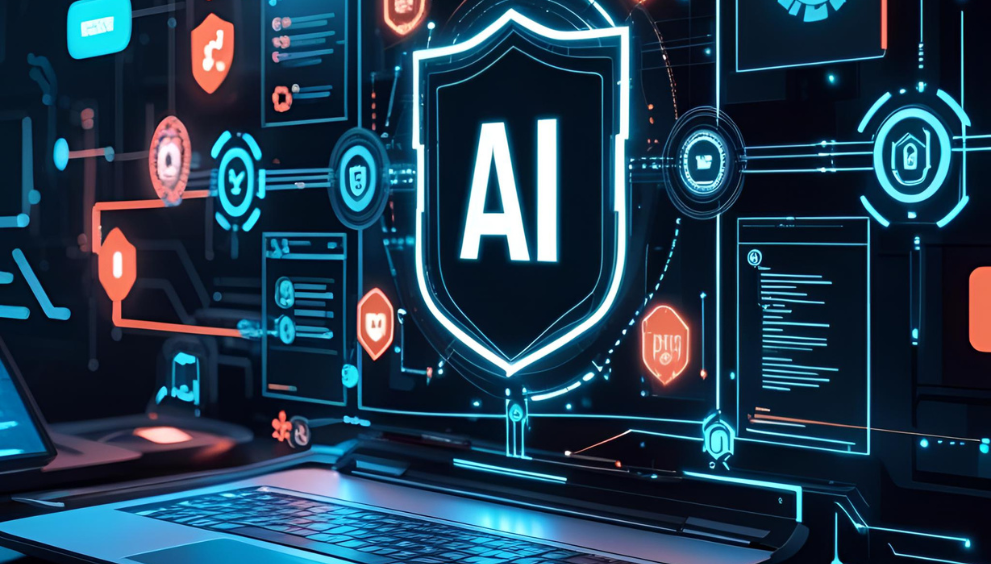The rising complexities of cyber threats demand a more advanced approach to cybersecurity systems. To fulfil this requirement, Artificial Intelligence (AI) can enhance and manage the overall digital space by improving threat detection and eliminating malware risks.
The following sections will present the role of AI in cyber security, along with discussing its benefits and challenges.
What Is Artificial Intelligence in Cybersecurity?
AI in cybersecurity integrates advanced technologies, such as machine learning and neural networks, into security frameworks. These technologies enable cybersecurity systems to analyse vast amounts of data, recognise patterns, and adapt to new and evolving threats with minimal human intervention.
AI-driven systems learn from experience, allowing them to predict, detect, and respond more effectively to known and unknown threats.
Key Ways AI Is Changing Cybersecurity
As cyberthreats are becoming advanced and their occurrence frequency is increasing, AI is emerging as an essential force to enhance modern cybersecurity. Cybersecurity with AI uses several advanced methods, which increase speed and effectiveness in cyber threat defence.
Real-Time Threat Detection Using AI
AI systems periodically analyse network traffic and user behaviour to detect suspicious activities. Integration of machine learning allows cybersecurity professionals to identify zero-day attacks. Cybersecurity and AI can identify unusual digital activities such as sudden access to sensitive data or unexpected login attempts. Upon the detection of such activities, the system immediately sends alerts to the cybersecurity teams.
AI-Powered Malware and Phishing Prevention
AI enhances cybersecurity protection by analysing links or files attached to emails or any other form of messaging service. It recognises suspicious communication style, false domains or disguised malicious codes. Cybersecurity with AI safeguards your PC or Laptop from evolving digital threats.
Enhancing Endpoint Protection with AI
Endpoints such as personal computers and remote workstations are often targeted by cyberattackers. Cybersecurity and AI protect against such occurrences by monitoring unauthorised software installations or unusual data transfers. When the potential risk is identified, AI isolates the program or device to prevent losses occurring due to digital attacks. Simultaneously, a notification is sent to the administrator of the computer or workstation.
Automating Incident Response for Faster Action
AI automates routine tasks such as log analysis, risk classification and initial migration steps as an incident response to cyberattacks. For instance, if a suspicious activity is detected, AI can immediately block specific access points and send alerts to the administrator.
Benefits of Using AI in Cybersecurity
AI is extensively changing cybersecurity practices, such as taking safety measures and responding to emerging threats. Here are some key benefits AI possess in cybersecurity:
Faster Threat Detection and Response
AI helps to improve the threat detection process by scanning millions of data access points across emails, network traffic, application behaviour and user activity. This facility allows security teams to respond better to cyberattacks.
For example, if AI detects that important files are being transferred from an unfamiliar IP address, it can instantly flag it as suspicious activity. For more severe conditions, AI can block the session or escalate the issue to an expert. This automated response can prevent your PC or Laptop from ransomware attacks or data theft.
Proactive Threat Prevention
With the use of machine learning algorithms, AI can analyse historical cyberattack patterns, vulnerability reports and real-time threat monitoring. This capability is specifically valuable against unknown or emerging threats.
Scalability and 24/7 Monitoring
AI-based cybersecurity systems are programmed in computers, which allows them to provide you with all-time protection from suspicious activities. It also helps cybersecurity operations centres to monitor complex environments.
Enhanced Data Security Across Devices
In the current era, cloud computing and IoT devices are emerging all across the globe. In order to protect such devices from digital attacks, AI enforces secure access controls to indicate a compromised device or account.
Challenges and Limitations of AI in Cybersecurity
The use of artificial intelligence in cybersecurity demands proper planning, human control and continuous optimisation. The most significant challenges and issues of implementing this machine learning based system are listed below:
High Dependence on Quality Data
AI applications need extensive data to train their systems. In cybersecurity, it implies providing AI with proper data about both the regular and previously discovered threats. Along with that, poor data may result in wrong predictions, missed threats or false alarms.
Complexity and Lack of Transparency
Most AI systems use deep learning models in their operation. AI detects or eliminates threats, but they do not explain in detail how it has made such decisions. This lack of transparency can cause problems when it comes to cybersecurity.
High Implementation and Maintenance Costs
Developing, training and maintaining an AI-based cybersecurity system requires significant financial investment and technical expertise. Moreover, the ongoing cost for retraining AI models also increases the overall maintenance cost of such systems.
How Quick Heal Uses AI to Keep You Safe
Quick Heal employs AI-based algorithms to prevent emerging cyber threats on a real-time basis, such as phishing, malware and fraudulent websites. Quick Heal’s antifraud tools examine online operations in real-time and block unauthorized transactions and data theft. This ensures that the users remain secure on devices and networks.
The Future of AI in Cybersecurity
Artificial intelligence is transforming the latest trends in cybersecurity by integrating predictive threat detection, autonomous response, and behaviour-based authentication.
AI is improving its strength with blockchain technology to maintain and enhance data integrity across computerised devices. These advancements will offer improved protection against more advanced cyber risks in a faster, smarter, and more dynamic way.
Frequently Asked Questions
-
Does Quick Heal use artificial intelligence to enhance threat detection?
Yes, Quick Heal uses a real-time advanced AI algorithm to monitor and analyse user behaviour and system activity. This helps identify and block emerging threats more quickly and accurately.
-
How is AI used to prevent phishing, malware, and ransomware attacks?
In order to prevent your PC or Laptop from phishing attacks, AI scans emails, URLs, and attachments for suspicious patterns. It periodically blocks phishing sites, malicious links, and unknown malware.
-
How does AI detect cyber threats faster than traditional methods?
AI continuously learns from vast datasets to recognise cyber attack patterns. It works alongside existing security methods to improve speed and accuracy in detecting emerging threats.



